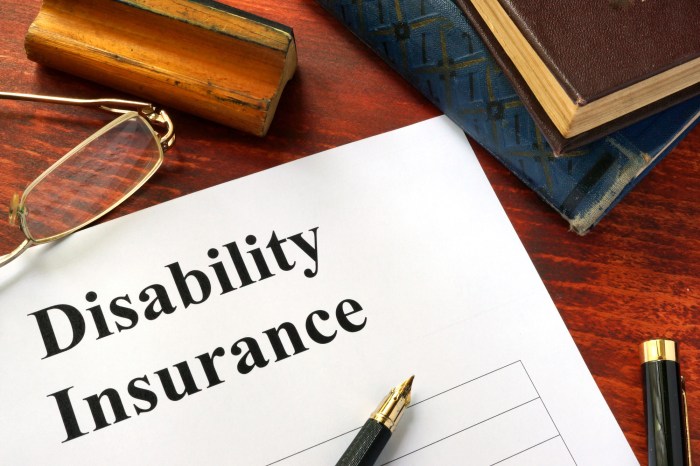Disability insurance options are crucial for financial security. Understanding the nuances of short-term versus long-term coverage, individual versus group policies, and the various definitions of disability is paramount. This guide explores the complexities of disability insurance, providing insights into cost factors, claim processes, and the role of insurance brokers, empowering you to make informed decisions about protecting your future income.
Navigating the world of disability insurance can feel overwhelming, with a wide array of policy types, coverage levels, and eligibility criteria to consider. However, by carefully evaluating your individual needs and circumstances, you can select a policy that offers appropriate protection without unnecessary expense. This guide will break down the key elements of disability insurance, offering clear explanations and practical advice to help you find the right fit.
Types of Disability Insurance
Disability insurance provides financial support when illness or injury prevents you from working. Understanding the different types available is crucial for choosing the right coverage to meet your individual needs and circumstances. This section will clarify the distinctions between short-term and long-term policies, as well as the various ways you can obtain disability insurance.
Short-Term vs. Long-Term Disability Insurance
Short-term and long-term disability insurance differ primarily in the duration of coverage they provide. Short-term disability insurance typically covers a period of a few months to a year, offering income replacement during temporary incapacitation. Long-term disability insurance, conversely, provides coverage for extended periods, often lasting until retirement age or a specified maximum duration, designed to address more serious and prolonged disabilities. The benefit amounts, waiting periods, and overall costs also vary significantly between these two types of coverage.
Types of Disability Insurance Policies
Several types of disability insurance policies cater to different needs and situations. Understanding the distinctions between individual, group, and employer-sponsored plans is essential for making an informed decision.
| Policy Type | Coverage Duration | Benefit Amount | Waiting Period | Elimination Period | Cost |
|---|---|---|---|---|---|
| Individual Disability Insurance | Varies; can be short-term or long-term, often up to retirement age. | Varies; typically a percentage of your income, often 60-70%. | Varies; typically 1-30 days. | Varies; typically 30-180 days (period before benefits start). | Varies; depends on coverage level, age, health, and occupation. Generally more expensive than group plans. |
| Group Disability Insurance | Typically short-term to a few years; some plans offer long-term options. | Usually a percentage of your income, often less than individual plans. | Varies; usually shorter than individual plans. | Varies; often shorter than individual plans. | Generally less expensive than individual plans; cost is often shared between employer and employee. |
| Employer-Sponsored Disability Insurance | Coverage duration and benefit amount vary greatly depending on the employer’s plan. May be short-term, long-term, or both. | Varies; typically a percentage of your income. | Varies; depends on the employer’s plan. | Varies; depends on the employer’s plan. | Cost is usually shared between the employer and employee, or fully covered by the employer. |
Defining Disability and Eligibility Criteria
Understanding the definition of disability and the eligibility criteria for disability insurance is crucial for securing adequate coverage. The specific terms and conditions vary significantly between insurance providers, impacting the likelihood of a successful claim. This section clarifies these complexities.
Eligibility for disability insurance hinges on a precise definition of “disability,” a term that insurance companies interpret in various ways. This interpretation directly affects the payout process and the claimant’s overall benefits. Furthermore, pre-existing conditions and policy exclusions play a significant role in determining coverage.
Disability Definitions
Insurance companies typically employ two primary definitions of disability: “own occupation” and “any occupation.” Under an “own occupation” definition, you are considered disabled if your injuries or illness prevent you from performing the main duties of your specific job. This definition is generally more favorable to the insured, offering broader coverage. Conversely, the “any occupation” definition deems you disabled only if your condition prevents you from performing any occupation for which you are reasonably suited by education, training, or experience. This definition is more restrictive, requiring a more significant impairment before benefits are paid. Some policies may also offer a hybrid approach, transitioning from an “own occupation” definition to an “any occupation” definition after a certain period.
Factors Affecting Eligibility
Several key factors influence an insurance company’s assessment of disability insurance eligibility. These include the severity and nature of the disability, the claimant’s medical history, the duration of the disability, and the claimant’s age and occupation. The insurer will thoroughly review medical records, conduct independent medical examinations if necessary, and investigate the claimant’s work history and ability to perform alternative job functions. For example, a highly specialized surgeon suffering from carpal tunnel syndrome might be deemed disabled under an “own occupation” definition, but not under an “any occupation” definition, as they could potentially transition to a less physically demanding role.
Pre-existing Conditions
Pre-existing conditions often impact eligibility and coverage under disability insurance policies. Most insurers have waiting periods (typically 6-12 months) before coverage begins for conditions that existed prior to the policy’s effective date. This waiting period helps to prevent individuals from purchasing insurance specifically to cover a known health issue. The insurer’s underwriting process will thoroughly assess the applicant’s medical history to identify and evaluate any pre-existing conditions. Policies may exclude coverage for specific pre-existing conditions altogether or may include limitations on the benefits payable for these conditions. For instance, someone with a history of back problems might find that their disability insurance policy excludes coverage for any future back-related disability claims for a specified period.
Common Policy Exclusions
It’s essential to understand that disability insurance policies typically exclude coverage for specific situations. Understanding these exclusions is vital for making an informed decision about your coverage.
- Self-inflicted injuries
- War or acts of terrorism
- Conditions resulting from illegal activities
- Pre-existing conditions (as noted above, with specific waiting periods and limitations)
- Mental health conditions, often subject to specific limitations or waiting periods
- Substance abuse or addiction
- Conditions caused by participation in hazardous activities (e.g., extreme sports)
Cost and Coverage Considerations: Disability Insurance Options
Choosing a disability insurance policy involves careful consideration of cost and coverage. The premiums you pay are influenced by several factors, and understanding how these factors interact is crucial to selecting a plan that meets your needs and budget. The balance between affordability and the level of protection offered is a key aspect of the decision-making process.
Understanding how premiums are calculated is essential for making informed choices. Several factors significantly influence the cost of disability insurance premiums.
Factors Influencing Disability Insurance Premiums
Several key factors influence the cost of your disability insurance premiums. A higher premium generally reflects a greater risk to the insurance company. These factors are interconnected, and their combined effect determines your individual premium.
- Age: Younger individuals generally pay lower premiums than older individuals because they have a statistically lower risk of disability.
- Health: Pre-existing conditions and current health status significantly impact premiums. Individuals with pre-existing conditions or health issues may face higher premiums or even be denied coverage.
- Occupation: High-risk occupations, such as construction or firefighting, carry higher premiums due to the increased likelihood of work-related injuries or disabilities.
- Benefit Amount: The higher the monthly benefit you choose, the higher your premium will be. This is directly proportional; a larger benefit requires a larger premium to cover the potential payout.
- Waiting Period: A longer waiting period (the time before benefits begin) generally results in lower premiums. This is because the insurance company’s risk is reduced with a longer waiting period.
- Benefit Period: Choosing a longer benefit period (the length of time benefits are paid) will increase your premium. A longer period represents a greater financial commitment from the insurer.
Hypothetical Scenario: Comparing Coverage Levels for a Software Engineer
Let’s consider a 35-year-old software engineer, Sarah, earning $100,000 annually. She’s considering three different disability insurance policies:
| Policy | Monthly Benefit | Waiting Period | Benefit Period | Approximate Monthly Premium |
|---|---|---|---|---|
| Policy A | $5,000 | 30 days | 2 years | $150 |
| Policy B | $6,667 (67% of income) | 90 days | 5 years | $200 |
| Policy C | $8,333 (83% of income) | 90 days | 10 years | $275 |
Policy A offers a lower monthly benefit and shorter benefit period, resulting in the lowest premium. Policy B provides a more substantial benefit and longer coverage but at a higher cost. Policy C offers the highest level of protection but demands the highest premium. Sarah must weigh the trade-off between cost and the level of financial security each policy provides. The choice depends on her individual risk tolerance and financial situation.
Benefit Amount Calculation and Influencing Factors, Disability insurance options
The benefit amount is often expressed as a percentage of your pre-disability income. Many policies offer benefits ranging from 60% to 70% of your income, though some may offer higher percentages. The actual benefit amount is usually subject to a maximum limit set by the policy.
The calculation is typically straightforward: Benefit Amount = (Percentage of Income) x (Pre-disability Income).
Several factors influence the final benefit amount, including:
- Policy terms: The specific terms of your policy will dictate the percentage of your income that is covered.
- Income verification: The insurer will verify your income through tax returns or pay stubs to determine the accurate benefit amount.
- Inflation adjustments: Some policies include adjustments for inflation, ensuring that your benefit keeps pace with rising living costs over time. This will, however, affect the premiums.
Claiming Disability Benefits

Filing a claim for disability benefits can seem daunting, but understanding the process can significantly ease the burden. This section Artikels the steps involved, necessary documentation, typical processing times, and strategies for handling potential claim denials. Remember, each insurance provider has its own specific procedures, so always refer to your policy documents and contact your insurer directly for the most accurate and up-to-date information.
The Claim Filing Process
The initial step involves notifying your insurance provider of your disability within the timeframe specified in your policy. This usually involves completing a claim form, providing a detailed description of your condition, and its impact on your ability to work. Following this, you’ll need to provide medical evidence supporting your claim. This is a crucial stage, and thorough documentation significantly increases the chances of a successful claim. After submitting your claim, you may be contacted for further information or a medical examination. The insurer will then review your claim, considering the provided documentation and the definition of disability Artikeld in your policy.
Gathering Necessary Documentation
Compiling the necessary documentation is essential for a strong claim. This typically includes medical records from your treating physician(s), detailing your diagnosis, treatment plan, prognosis, and limitations. These records should clearly demonstrate the severity of your condition and its impact on your ability to perform your job duties. In addition to medical records, you may need to provide employment records, such as your job description, work history, and any documentation related to lost wages. Consider gathering any supporting evidence like physical therapy notes, occupational therapy reports, or letters from specialists. The more comprehensive your documentation, the stronger your case. For example, a detailed doctor’s report outlining specific functional limitations, supported by objective test results (e.g., MRI scans, blood tests), will carry more weight than a brief note stating general disability.
Disability Claim Processing Timeframes
Processing times for disability claims vary significantly depending on the insurer, the complexity of the case, and the completeness of the documentation provided. Some claims might be processed within a few weeks, while others can take several months or even longer. Many insurers provide estimated processing times in their policy documents. For instance, a straightforward claim with clear medical evidence might be processed within 2-3 months, while a complex case involving multiple medical conditions and extensive documentation could take 6-12 months or more. It is crucial to be patient and proactive in following up with your insurer throughout the process.
Reasons for Claim Denials and Appeal Strategies
Claim denials often stem from insufficient medical evidence, discrepancies between the claimed disability and the policy definition, or failure to meet the eligibility criteria. For example, a denial might occur if the medical evidence doesn’t clearly link your condition to your inability to work, or if the condition is deemed not severe enough to meet the policy’s definition of disability. Another common reason is the failure to submit all required documentation within the specified timeframe. If your claim is denied, understanding the reasons for the denial is the first step in appealing the decision. Carefully review the denial letter, gather any additional supporting evidence, and prepare a well-documented appeal. This might involve obtaining additional medical opinions, clarifying any ambiguities in your initial claim, or addressing any inconsistencies identified by the insurer. Many insurers have a formal appeals process, which usually involves submitting a written appeal and potentially attending a hearing.
Finding and Choosing a Disability Insurance Provider
Selecting the right disability insurance provider is crucial, as this decision directly impacts your financial security in the event of an unforeseen illness or injury. A thorough understanding of different providers and their offerings is essential to making an informed choice. This section will guide you through the process of comparing providers and identifying key factors to consider.
Choosing a disability insurance provider involves careful consideration of several key aspects. It’s not simply about finding the cheapest policy; rather, it’s about finding a provider that offers the right balance of cost, coverage, and reliability. This requires comparing several providers and understanding their strengths and weaknesses.
Provider Service Comparisons
Different disability insurance providers offer varying levels of service. Some may specialize in specific industries or types of disabilities, while others offer broader coverage. For example, some providers might excel in their claims processing speed, while others may be known for their exceptional customer service. Comparing these aspects is vital for determining which provider best suits your individual needs and preferences. Consider factors such as the breadth of their policy options, the accessibility of their customer service channels (phone, email, online portal), and the overall reputation for responsiveness. Independent reviews and ratings from organizations like the Better Business Bureau can provide valuable insights into a provider’s performance.
Factors to Consider When Selecting a Provider
Several critical factors should influence your decision. Prioritizing these aspects will help you select a provider that offers both comprehensive coverage and reliable service.
- Financial Stability: A provider’s financial strength is paramount. A financially sound company is more likely to be able to pay out claims even during challenging economic times. You can assess this by checking their ratings from agencies like A.M. Best, Moody’s, and Standard & Poor’s.
- Customer Service: Excellent customer service is crucial, especially during a stressful time like filing a disability claim. Look for providers with readily available customer support via phone, email, and online portals, and check reviews to gauge the quality of their responsiveness and helpfulness.
- Claims Processing Speed and Efficiency: The speed and efficiency of the claims process are critical. A provider with a reputation for swift and straightforward claims processing will minimize the financial strain during a disability.
- Policy Exclusions and Limitations: Carefully review the policy’s exclusions and limitations to understand what is and isn’t covered. Some policies may exclude pre-existing conditions or specific types of disabilities.
- Policy Renewability and Portability: Understand the terms of policy renewability and portability. Can you renew your policy as you age? Can you take your policy with you if you change jobs?
- Reputation and Reviews: Research the provider’s reputation by checking independent reviews and ratings from various sources. This will provide insights into their claims-handling practices and overall customer satisfaction.
Questions to Ask Potential Providers
Before committing to a policy, it is essential to ask specific questions to ensure the provider meets your needs. This proactive approach will help you avoid potential problems down the line.
- What is your claims approval rate and average processing time?
- What are the specific exclusions and limitations of your policy?
- What is your financial strength rating from independent rating agencies?
- What are your customer service options and availability?
- What is your process for appealing a denied claim?
- What types of disabilities are covered under your policy?
- What is the definition of disability used in your policy?
- What are the terms of policy renewability and portability?
The Role of an Insurance Broker

Navigating the complex world of disability insurance can be challenging. Understanding policy nuances, comparing coverage options from different providers, and ensuring adequate protection for your future can feel overwhelming. This is where an insurance broker can play a crucial role, acting as your advocate and guide throughout the process. Their expertise can significantly simplify the search for suitable disability insurance and help you secure the best possible coverage.
An insurance broker acts as an intermediary between you and multiple insurance companies. Unlike agents who represent a single company, brokers have access to a wider range of policies and can compare options from various providers to find the best fit for your individual needs and budget. This impartial perspective allows them to recommend policies that offer optimal coverage at competitive prices, saving you time and effort in the process. Their deep understanding of the disability insurance market ensures you receive informed advice and avoid costly mistakes.
Services Provided by Disability Insurance Brokers
Brokers offer a comprehensive suite of services designed to streamline the disability insurance selection process. These services typically include initial consultations to assess your needs, a thorough market analysis to identify suitable policies, assistance with the application process, and ongoing support throughout the policy’s lifecycle. Their expertise extends to helping you understand complex policy terms, ensuring you choose coverage that adequately protects your income and lifestyle. They can also provide valuable guidance on optimizing your premiums while maximizing your benefits. Furthermore, brokers often assist with claims management, navigating the often-complicated claims process to ensure a smoother experience and a timely resolution.
Costs Associated with Using an Insurance Broker
The cost of using a disability insurance broker varies depending on the broker’s fee structure and the complexity of your needs. Some brokers charge a flat fee, while others operate on a commission basis, receiving a percentage of the premium from the insurance company. It’s important to understand the broker’s fee structure upfront to avoid any surprises. While there is a cost associated with their services, the value they bring in terms of time saved, access to a wider range of options, and expert advice often outweighs the expense. The potential financial benefits of securing a more comprehensive and cost-effective policy, thanks to the broker’s expertise, can significantly exceed their fees. For instance, a broker might help you secure a policy with lower premiums or higher benefit payouts, ultimately saving you a considerable amount over the policy’s term. Consider the broker’s fees as an investment in securing optimal disability insurance protection.
Disability Insurance and Other Insurance Policies

Disability insurance doesn’t exist in a vacuum; its coverage often interacts significantly with other insurance policies you might hold, creating both opportunities for comprehensive protection and potential gaps in coverage. Understanding these interactions is crucial for ensuring you have adequate financial security in the event of a disabling illness or injury. This section will explore the relationships between disability insurance and other common insurance types, highlighting potential overlaps and areas where coverage might fall short.
Disability insurance frequently interacts with health insurance and long-term care insurance, among others. The interplay can be complex, depending on the specific policies and their terms. Careful planning and understanding of policy limitations are essential to avoid unforeseen financial burdens.
Interaction with Health Insurance
Health insurance primarily covers medical expenses resulting from illness or injury. Disability insurance, conversely, focuses on replacing lost income. While they address different aspects of disability, there can be overlap. For instance, a serious illness requiring extensive rehabilitation might be covered by both policies: health insurance for medical bills and disability insurance for lost wages during recovery. However, a gap might exist if the disability prevents work but doesn’t involve significant ongoing medical costs. Consider a person with a chronic back injury that prevents them from working but doesn’t require frequent or expensive medical treatment. Their health insurance may not offer substantial assistance, leaving their disability insurance as the primary financial safety net.
Interaction with Long-Term Care Insurance
Long-term care insurance typically covers expenses related to extended care, such as nursing home stays or in-home assistance. Disability insurance, again, addresses income replacement. Overlap can occur if a disability necessitates long-term care, with long-term care insurance covering the cost of care while disability insurance covers lost income. However, there could be a coverage gap if the disability doesn’t require long-term care but still prevents work, leaving the individual solely reliant on their disability insurance. For example, someone with a severe cognitive impairment requiring full-time care would benefit from both policies. Conversely, an individual with a disabling injury that prevents work but allows them to live independently would rely primarily on disability insurance.
Examples of Comprehensive Coverage through Multiple Policies
Consider a scenario where an individual experiences a stroke. Their health insurance covers the immediate medical expenses—hospital stay, rehabilitation, and ongoing medication. Their disability insurance replaces their lost income during recovery and beyond, if the stroke results in a long-term disability. Finally, if the stroke results in long-term care needs, their long-term care insurance steps in to cover the costs of assisted living or in-home care. This illustrates how multiple policies can work synergistically to provide holistic financial protection. In contrast, if the individual only had health insurance, they might face significant financial hardship due to lost income during recovery and potential ongoing care costs. The absence of disability insurance would create a significant gap in financial security.
Securing adequate disability insurance is a proactive step towards safeguarding your financial well-being. By understanding the different policy types, eligibility requirements, and claim processes, you can confidently navigate the complexities of this critical coverage. Remember to carefully consider your individual needs, explore various provider options, and, if necessary, consult with an insurance broker to find the best fit for your circumstances. Protecting your income stream against unforeseen disability is an investment in your future security and peace of mind.
Popular Questions
What is the difference between own occupation and any occupation disability definitions?
“Own occupation” defines disability as the inability to perform the duties of your specific job. “Any occupation” defines disability as the inability to perform any job for which you are reasonably suited by education, training, or experience.
How long does it typically take to process a disability claim?
Processing times vary by insurer and the complexity of the claim, but it can range from a few weeks to several months.
Can I get disability insurance if I have a pre-existing condition?
Many insurers will cover pre-existing conditions, but there might be exclusions or waiting periods before coverage begins. Full disclosure is crucial.
What factors influence the cost of disability insurance?
Factors such as age, health, occupation, benefit amount, and the length of the benefit period all significantly impact the cost of your premiums.
What happens if my disability claim is denied?
Most insurers have an appeals process. You should carefully review the denial reasons and gather additional supporting documentation to strengthen your appeal.
